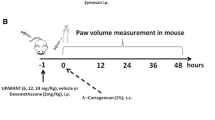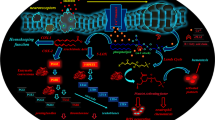Conclusion
Ebselen has been demonstrated to be an effective anti-inflammatory agent in a variety of experimental modelsin vivo which differ from classical tests in that the aetiological roles of hydroperoxides and/or lipoxygenase products appear to be greater. Indeed, ebselen exhibits only weak anti-inflammatory activity in the traditional prostaglandin-dominated models, such as carrageenan paw oedema, adjuvant arthritis and yeast paw hyperalgesia [50]. The major targets of this anti-inflammatory activity appear to be plasma exudation and infiltration, possibly as a result of the inhibition of the hydroperoxide and/or leukotriene effects on leukocyte-endothelium interactions. Both reactive oxygen species [24] and LTB4 [51, 52] enhance granulocyte adhesiveness to endothelium and ebselen inhibits the generation of reactive oxygen species, catalyses the breakdown of hydroperoxides, inactivates LTB4 by isomerization and inhibits 5-lipoxygenase [9–11, 13–16, 27–29]. Consequently, any or all of these mechanisms of action, together with inhibition of hypoxic-reperfusion injury [53], could contribute to the anti-inflammatory activity of ebselen.
With regard to tissue injury, the inhibitory action of ebselen on gastric mucosal injury clearly bodes well for its clinical use and offers a big advantage over current NSAIDs.In vitro findings indicate that the compound may inhibit gastric acid secretion directly [54]. As an inhibitor of hepatic pancreatic and cerebral tissue injury, ebselen also opens up new perspectives for therapy which are being actively pursued. Studies on the mechanism of action of ebselen in these experimental tissue injury models point towards inhibition of 5-lipoxygenase products, though the GSH-Px like action may also play a role. In experimental liver injury, tumor necrosis factor (TNF) has been shown to be the final mediator of endotoxin action [55] and it will be of interest to see whether ebselen is able to affect the actions of this cytokine, both in the liver and at other sites, including TNF-induced leukocyte adhesion [56]. The last word on the pharmacology of ebselen is far from being spoken or written!
Similar content being viewed by others
References
D. R. Blake, J. Lunec, S. Brailsford, P. G. Winyard and P. A. Bacon,Oxygen free radicals and inflammatory joint disease. InPerspectives in rheumatology (Ed. J. L. Decker and J. T. Scott) pp. 19–33, Current Medical Literature, London 1985.
P. A. Ward, J. S. Warren and K. J. Johnson,Oxygen radicals, inflammation, and tissue injury. Free Rad. Biol. Med.5, 403–408 (1988).
M. J. Parnham,Reactive oxygen species in inflammation and rheumatoid arthritis. Pharm. Weekbl.125, 529–535.
L. Flohe, H. Giertz and R. Beckmann,Free radical scavengers as anti-inflammatory drugs? InThe pharmacology of inflammation. Handbook of Inflammation, Vol. 5. (Ed. I. L. Bonta, M. A. Bray and M. J. Parnham) pp. 255–282, Elsevier, Amsterdam 1985.
K. F. Swingle, R. L. Bell and G. G. I. Moore,Anti-inflammatory activity of antioxidants. InAnti-inflammatory and natirheumatic drugs, Vol. 3 (ED. K. D. Rainsford) pp. 105–126, CRC Press, Boca Raton 1985.
H. Vapaatalo,Free radicals and anti-inflammatory drugs, Med. Biol.64, 1–7 (1986).
M. J. Parnham and E. Graf,Seleno-organic compounds and the therapy of hydroperoxide-linked pathological conditions. Biochem. Pharmacol.36, 3095–3102 (1987).
M. J. Parnham, E. Graf, P. Kuhl and S. Leyck,Seleno-organic therapy of inflammation. Adv. Inflam. Res.12, 257–267 (1988).
A. Müller, E. Cadenas, P. Graf and H. Sies,A novel biologically active seleno-organic compound-I. Glutathione peroxidase-like activity in vitro and antioxidant capacity of PZ 51 (ebselen). Biochem. Pharmacol.33, 3235–3239 (1984).
H. Fischer and N. Dereu,Mechanism of the catalytic reduction of hydroperoxides by ebselen: a selenium-77 NMR study. Bull. Soc. Chim. Belg.96, 757–768 (1987).
A. Wendel, M. Fausel, H. Safayhi, G. Tiegs and R. Otter,A novel biologically active seleno-organic compound-II. Activity of PZ 51 in relation to glutathione peroxidase. Biochem Pharmacol.33, 3241–3245 (1984).
M. J. Parnham, J. Biedermann, Ch. Bittner, N. Dereu, S. Leyck and H. Wetzig,Structure-activity relationship of a series of anti-inflammatory benzisoselenazolones (BISAs). Agents and Actions27, 306–308 (1989).
H. Safayhi, G. Tiegs and A. Wendel,A novel biologically active seleno-organic compound-V. Inhibition by ebselen (PZ 51) of rat peritoneal neutrophil lipoxygenase. Biochem. Pharmacol.34, 2691–2694 (1985).
P. Kuhl, H. O. Borbe, H. Fischer, A. Römer and H. Safayhi,Abselen reduces the formation of LTB4 in human and porcine leukocytes by isomerization to its 5S, 12R-6-trans-isomer. Prostaglandins31, 1029–1048 (1986).
M. J. Parnham and S. Kindt,A novel biologically active seleno-organic compound-III. Effects of PZ 51 (ebselen) on glutathione peroxidase and secretory activities of mouse macrophages. Biochem. Pharmacol.33, 3247–3250 (1984).
W. Englberger and M. J. Parnham,Inhibition by ebselen of macrophage eicosanoid generation and lymphocyte proliferation in vitro. Br. J. Pharmacol.87, 15P (1986).
S. Leyck and M. J. Parnham,Acute anti-inflammatory and gastric effects of the seleno-organic compound ebselen. Agents and Action30, 426–431.
H. Fischer, R. Terlinden, J. P. Löhr and A. Römer,A novel biologically active seleno-organic compound. VIII. Biotransformation of ebselen. Xenobiotica18, 1347–1359 (1988).
S. Leyck, E. Etschenberg, U. Hadding and J. Winkelmann,A new model of acute inflammation: cobra venom factor induced paw oedema. Agents and Actions13, 437–438, (1983).
W. Englberger, U. Hadding, E. Etschenberg, E. Graf, S. Leyck, J. Winkelmann and M. J. Parnham,Rosmarinic acid: a new inhibitor of complement C3-convertase with anti-inflammatory activity. Int. J. Immunopharmac.10, 729–737 (1988).
J. Schalkwijk, W. B. van den Berg, L. B. A. van de Putte and L. A. B. Joosten,An experimental model for hydrogen peroxide induced tissue damage. Effects of a single inflammatory mediator on (peri) articular tissue. Arthr. Rheum.29, 532–538 (1986).
E. J. Dowling, M. J. Parnham, C. J. Morris, A. Dabbagh and D. R. Blake,An experimental model of ROS-mediated endothelial cell damage. J. Leuk. Biol.46, 336 (1989).
E. J. Dowling, M. J. Parnham, T. Sahinoglu, P. Howley, C. J. Morris and D. R. Blake,A study of ebselen in experimental inflammation. Br. J. Rheumatol.23, 16 (1990).
R. F. Del Maestro, M. Planker and K.-E. Arfors,Evidence for the participation of superoxide anion radical in altering the adhesive interaction between granulocytes and endothelium, in vivo. Int. J. Microcirc: Clin. Exp.1, 105–120 (1982).
A. Ager and J. L. Gordon,Differential effects of hydrogen peroxide on indices of endothelial cell function. J. Exp. Med.159, 592–603 (1984).
J. Varani, I. Ginsburg, L. Schuger, D. F. Gibbs, J. Bromberg, K. J. Johnson, U. S. Ryan and P. A. Ward,Endothelial killing by neutrophils. Synergistic interaction of oxygen products and proteases. Am. J. Pathol.135, 435–438 (1989).
S. Ichikawa, K. Omura, T. Katayama, N. Okamura, T. Ohtsuka, S. Ishibashi and H. Masayasu,Inhibition of superoxide anion production in guinea pig polymorphonuclear leukocytes by a seleno-organic compound Ebselen. J. Pharmacobiodyn.10, 595–597 (1987).
I. A. Cotgreave, S. A. Duddy, G. E. N. Kass, D. Thompson and P. Moldeus,Studies on the anti-inflammatory activity of ebselen. Ebselen interferes with granulocyte oxidative burst by dual inhibition of NADPH oxidase and protein kinase C? Biochem. Pharmacol.38, 649–656 (1989).
L. Leurs, H. Timmerman and A. Bast,Inhibition of superoxide anion radical production by ebselen (PZ 51) and its sulfur analogue (PZ 25) in guinea alveolar macrophages. Biochem. Int.18, 295–299 (1989).
I. A. Cotgreave, U. Johansson, G. Westergren, P. W. Moldeus and R. Brattsand,The anti-inflammatory activity of Ebselen but not thiols in experimental alveolitis and bronchiolitis. Agents and Actions24, 313–319 (1988).
C. Von Ritter, M. B. Grisham, M. Höllwarth, W. Inauen and D. N. Granger,Neutrophil-derived oxidants mediate formyl-methionyl-leucyl-phenylalanine-induced increases in mucosal permeability in rats. Gastroenterology97, 778–780 (1989).
H. P. Hartung, B. Schäfer, K. Heininger and K. V. Toyka,Interference with arachidonic acid metabolism suppresses experimental allergic neuritis. Ann. Neurol.20, 168 (1986).
T. E. Van Dyke, L. Braswell and S. Offenbacher,Inhibition of gingivitis by topical application of ebselen and rosmarinic acid. Agents and Actions19, 376 (1986).
Y. Kurebayashi, Y. Tabuchi and M. Akasaki,Gastric cytoprotection by ebselen against the injury induced by necrotizing agents in rats. Arzneim. Forsch./Drug Res.39, 250–253 (1989).
A. Müller, H. Gabriel and H. Sies,A novel biologically active selenoorganic compound-IV. Protective glutathione-dependant effect of PZ 51 (ebselen) against ADP-Fe induced lipid peroxidation in isolated hepatocytes. Biochem. Pharmacol.34, 1185–1189 (1985).
M. Hayashi and T. F. Slater,Inhibitory effects of ebselen on lipid peroxidation in rat liver microsomes. Free Rad. Res. Comm.2, 179–185 (1986).
A. Wendel and G. Tiegs,A novel biologically active seleno-organic compound-VI. Protection by ebselen (PZ 51) against galactosamine/endotoxin-induced hepatitis in mice. Biochem. Pharmacol.35, 2115–2118 (1986).
G. Tiegs and A. Wendel,Leukotriene-mediated liver injury. Biochem. Pharmacol.37, 2569–2573 (1988).
M. Akasaki, T. Ikeda, F. Numata, Y. Kurebayashi and W. Tsukada,Effect of ebselen (PZ 51) in liver failure induced by Propionibacterium acnes (p. acnes). InSelenium in biology and medicine (Ed. A. Wendel) pp. 169–172, Springer-Verlag, Berlin, Heidelberg 1989.
W. Hagmann, A.-M. Steffan, A. Kirn and D. Keppler,Leukotrienes as mediators in frog virus 3-induced hepatitis in rats. Hepatology7, 732–736 (1987).
M. Mourelle, J. L. Amezcua and V. Pérez-Alvarez,Reduction of apparent indicators of liver cirrhosis in rats by the arachidonate lipoxygenase inhibitor BW 755C. Eur. J. Pharmacol.134, 175–180 (1987).
C. Niederau, K. Ude, M. Niederau, R. Lüthen, G. Strohmeyer, L. D. Ferrell and J. H. Grendell,Effects of the seleno-organic substance ebselen in two different models of acute pancreatitis. Pancreas, in press.
K.-H. Konz, G. Tiegs and A. Wendel,Protection by ebselen against endotoxin shock in rats or mice sensitized by galactosamine. InPathophysiological role of mediators and mediator inhibitors in shock. First Vienna Shock Forum, Part A (Ed. G. Schlag and H. Redl) pp. 281–288, Alan R. Liss, New York 1987.
K. Kogure, H. Arai, K. Abe and M. Nakano,Free radical damage of the brain following ischemia. Progr. Brain Res.63, 237–259 (1985).
D. J. Hearse,Ischemia, reperfusion and free radical damage. InFree Radicals, Oxidant Stress and Drug Action (Ed. C. Rice-Evans) pp. 13–42, Richelieu, London 1987.
H. De Groot and A. Littauer,Hypoxia, reactive oxygen, and cell injury. Free Rad. Biol. Med.6, 541–551 (1989).
T. Hashizume, S. Ide and Y. Shimoto,Effect of ebselen (PZ 51) on experimental liver injury models. InAbstracts, 4ty international symposium on selenium in biology and medicine, p. 38, University of Tübingen, July 1988.
T. Watanabe, M. Nishiyama, H. Okamoto, T. Hori, T. Asano, T. Shimizu and H. Masayasu,Effects of ebselen (PZ 51) on experimental cerebral vasospasm. InSelenium in biology and medicine (Ed. A. Wendel) pp. 177–184, Springer-Verlag, Berlin, Heidelberg 1989.
J. Tamaka and F. Yamada,Ebselen (PZ 51) inhibits the formation of ischemia brain edema. InSelenium in biology and medicine (Ed. A. Wendel) pp. 173–176, Springer-Verlag, Berlin, Heidelberg 1989.
M. J. Parnham, S. Leyck, N. Dereu, J. Winkelmann and E. Graf,Ebselen (PZ 51): a GSH-peroxidase-like organoselenium compound with anti-inflammatory activity. Adv. Inflam. Res.10, 397–400 (1985).
R. L. Hoover, M. J. Karnovsky, K. F. Austen, E. J. Corey and R. A. Lewis,Leukotriene B4 action on endothelium mediates augmented neutrophil/endothelial adhesion. Proc. Natl. Acad Sci. USA81, 2191–2193 (1984).
M. A. Gimbrone, A. F. Brock and A. I. Schafer,Leukotriene B4 stimulates polymorphonuclear leukocyte adhesion to cultured vascular endothelial cells. J. Clin. Invest.74, 1552–1555 (1984).
D. R. Blake, P. Merry, J. Unsworth, B. L. Kidd, J. M. Outhwaite, R. Ballard, C. J. Morris, L. Gray and J. Lunec,Hypoxic-reperfusion injury in the inflamed joint. Lanceti, 289–294 (1989).
W. Beil, U. Staar and K.-F. Sewing,Interaction of the anti-inflammatory seleno-organic compound ebselen with acid secretion in isolated parietal cells and gastric H+/K+-ATPAse. Biochem. Pharmacol.40, 1997–2003.
G. Tiegs, M. Wolter and A. Wendel,Tumor necrosis factor is a terminal mediator in galactosamine/endotoxin-induced hepatitis in mice. Biochem. Pharmacol.38, 627–631 (1989).
J. M. Munroe, J. S. Pober and R. S. Cotran,Tumor necrosis factor and interferon-induce distinct patterns of endothelial activation and associated leukocyte accumulation in skin of Papio anubis. Am. J. Pathol.135, 121–133 (1989).
Author information
Authors and Affiliations
Rights and permissions
About this article
Cite this article
Parnham, M.J., Leyck, S., Graf, E. et al. The pharmacology of ebselen. Agents and Actions 32, 4–9 (1991). https://doi.org/10.1007/BF01983300
Issue Date:
DOI: https://doi.org/10.1007/BF01983300




